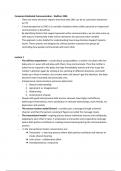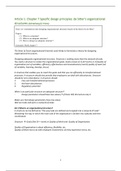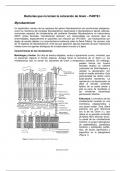Appendix
Chapter: Page
1- General Physics 2
2- Measurements 18
3- Kinematics 30
4- Dynamics 55
5- Effect of Forces (Moment and Pressure) 74
6- Work, Energy and Power 84
7- Deformation of Solids 96
8- Electric Fields 106
9- Electric Circuits 112
10- Waves Properties 134
11- Superposition of Waves 151
12- Atomic Physics and Radioactivity 179
1
Mr. Hussein Khaled
, Chapter 1
General Physics
Any physical quantity has a numerical value (Magnitude) and a unit.
• For example the mass of a student = 72 kg
• Speed of car = 25 ms-1
The system of units used is called the international system of units (SI units), which includes 7
base units.
Physical Quantity Unit
Mass kilogram (kg)
Length meter (m)
Time Seconds (s)
Temperature kelvin (K)
Electric Current ampere (A)
Amount of substance (A2) Mole (mol)
Luminous intensity (A2) Candela (cd)
All other units can be derived from these base units. We can get the unit of the derived quantity
be multiplying or dividing the base units.
Hint: Addition or subtraction of units gives the same unit. Ex: 5m + 2m = 7m
Derived Quantity Unit
Area m2
Volume m3
Density kg m-3
Velocity ms-1
Acceleration ms-2
Force kg ms-2 Newton (N)
Energy kg m2s-2 Joule (J)
Power kg m2s-3 watt (W)
Momentum kg ms-1
Pressure kg m-1s-2 pascal (Pa)
Electric Charge As Coulomb (C)
Potential Difference/ Electromotive Force kg m2s-3 A -1 Volt (V)
Electric resistance kg m2s-3 A -2 ohms (Ω)
2
Mr. Hussein Khaled
, We use homogeneous equation → both sides of equation have same units.
Ex:
F=mxa
N = kg x ms-2
N = kg m s-2
Ex:
E = mc2
J = kg x (ms-1)2
J = kg x m2s-2
J = kg m2 s-2
Ex: The power (P) of wind turbine is affected by the length (L) of each blade, the density of the
air (ρ) and the wind speed (v) following this equation.
Ρ= C L2 ρ v3
Show that the constant C has no units.
𝑃 𝑘𝑔 𝑚2 𝑠−3
Answer: C= =
𝐿2 𝜌 𝑣 3 𝑚2 𝑘𝑔 𝑚−3 (𝑚𝑠 −1 )3
= 𝑘𝑔1−1 𝑚2−2+3−3 𝑠 −3+3 = 𝑘𝑔0 𝑚0 𝑠 0 = 1 (no units)
Ex:
Drag Force equation: F = 6π η r v
F: Force
r: radius
v: velocity
η: constant Find the SI base units of the constant η.
3
Mr. Hussein Khaled Answer: 𝑲𝒈 𝒎−𝟏 𝒔−𝟏
, Prefixes
In physics, we have to deal with very small and very large numbers, so numbers are
expressed using powers of 10 (this is called scientific notation). Prefixes are
abbreviations of these powers of 10.
Ex: A building of height 2300 m can be written as 2.3x103 = 2.3 km
(k is the prefix in this case)
Prefix Symbol Value
deci d X10 -1
centi C X10 -2
milli m X10 -3
micro μ X10 -6
nano n X10 -9
pico p X10 -12
kilo k X10 3
mega M X10 6
giga G X10 9
tera T X10 12
a) 60 pm = ? m b) 700 m = ? pm
Scalars vs Vectors
Any physical quantity can be either scalar or vector.
a) Scalar: quantity that has magnitude only.
Ex: mass, length (distance), power, temperature, speed, energy, charge,
time, current, resistance.
b) Vector: quantity that has magnitude and direction.
Ex: displacement, weight, velocity, acceleration, force, momentum, moment
(Torque).
4
Mr. Hussein Khaled
Chapter: Page
1- General Physics 2
2- Measurements 18
3- Kinematics 30
4- Dynamics 55
5- Effect of Forces (Moment and Pressure) 74
6- Work, Energy and Power 84
7- Deformation of Solids 96
8- Electric Fields 106
9- Electric Circuits 112
10- Waves Properties 134
11- Superposition of Waves 151
12- Atomic Physics and Radioactivity 179
1
Mr. Hussein Khaled
, Chapter 1
General Physics
Any physical quantity has a numerical value (Magnitude) and a unit.
• For example the mass of a student = 72 kg
• Speed of car = 25 ms-1
The system of units used is called the international system of units (SI units), which includes 7
base units.
Physical Quantity Unit
Mass kilogram (kg)
Length meter (m)
Time Seconds (s)
Temperature kelvin (K)
Electric Current ampere (A)
Amount of substance (A2) Mole (mol)
Luminous intensity (A2) Candela (cd)
All other units can be derived from these base units. We can get the unit of the derived quantity
be multiplying or dividing the base units.
Hint: Addition or subtraction of units gives the same unit. Ex: 5m + 2m = 7m
Derived Quantity Unit
Area m2
Volume m3
Density kg m-3
Velocity ms-1
Acceleration ms-2
Force kg ms-2 Newton (N)
Energy kg m2s-2 Joule (J)
Power kg m2s-3 watt (W)
Momentum kg ms-1
Pressure kg m-1s-2 pascal (Pa)
Electric Charge As Coulomb (C)
Potential Difference/ Electromotive Force kg m2s-3 A -1 Volt (V)
Electric resistance kg m2s-3 A -2 ohms (Ω)
2
Mr. Hussein Khaled
, We use homogeneous equation → both sides of equation have same units.
Ex:
F=mxa
N = kg x ms-2
N = kg m s-2
Ex:
E = mc2
J = kg x (ms-1)2
J = kg x m2s-2
J = kg m2 s-2
Ex: The power (P) of wind turbine is affected by the length (L) of each blade, the density of the
air (ρ) and the wind speed (v) following this equation.
Ρ= C L2 ρ v3
Show that the constant C has no units.
𝑃 𝑘𝑔 𝑚2 𝑠−3
Answer: C= =
𝐿2 𝜌 𝑣 3 𝑚2 𝑘𝑔 𝑚−3 (𝑚𝑠 −1 )3
= 𝑘𝑔1−1 𝑚2−2+3−3 𝑠 −3+3 = 𝑘𝑔0 𝑚0 𝑠 0 = 1 (no units)
Ex:
Drag Force equation: F = 6π η r v
F: Force
r: radius
v: velocity
η: constant Find the SI base units of the constant η.
3
Mr. Hussein Khaled Answer: 𝑲𝒈 𝒎−𝟏 𝒔−𝟏
, Prefixes
In physics, we have to deal with very small and very large numbers, so numbers are
expressed using powers of 10 (this is called scientific notation). Prefixes are
abbreviations of these powers of 10.
Ex: A building of height 2300 m can be written as 2.3x103 = 2.3 km
(k is the prefix in this case)
Prefix Symbol Value
deci d X10 -1
centi C X10 -2
milli m X10 -3
micro μ X10 -6
nano n X10 -9
pico p X10 -12
kilo k X10 3
mega M X10 6
giga G X10 9
tera T X10 12
a) 60 pm = ? m b) 700 m = ? pm
Scalars vs Vectors
Any physical quantity can be either scalar or vector.
a) Scalar: quantity that has magnitude only.
Ex: mass, length (distance), power, temperature, speed, energy, charge,
time, current, resistance.
b) Vector: quantity that has magnitude and direction.
Ex: displacement, weight, velocity, acceleration, force, momentum, moment
(Torque).
4
Mr. Hussein Khaled










